Brief Review of Epitaxy and Emission Properties of GaSb and Related Semiconductors
Abstract
:1. Introduction
2. Epitaxy of GaSb Materials
3. Optical and Emission Properties of GaSb Materials
3.1. GaSb Emission Properties
3.2. GaSb Alloy Emission Properties
3.3. Effects of Surface States on GaSb Materials
4. Low-Dimensional Nanostructures of GaSb Materials
5. Conclusions
Acknowledgments
Author Contributions
Conflicts of Interest
References
- Borg, B.M.; Wernersson, L.E. Synthesis and properties of antimonide nanowires. Nanotechnology 2013, 24, 202001. [Google Scholar] [CrossRef] [PubMed]
- Cui, Q.; Yang, Y.; Li, J.; Teng, F.; Wang, X. Material and device architecture engineering toward high performance two-dimensional (2D) photodetectors. Crystals 2017, 7, 149. [Google Scholar] [CrossRef]
- Chen, H.; Liu, H.; Zhang, Z.; Hu, K.; Fang, X. Nanostructured photodetectors: From ultraviolet to terahertz. Adv. Mater. 2016, 28, 403–433. [Google Scholar] [CrossRef] [PubMed]
- Zhang, Y.; Wu, J.; Aagesen, M.; Liu, H. III–V nanowires and nanowire optoelectronic devices. J. Phys. D Appl. Phys. 2015, 48, 463001. [Google Scholar] [CrossRef]
- Li, L.; Pan, D.; Xue, Y.; Wang, X.; Lin, M.; Su, D.; Zhang, Q.; Yu, X.; So, H.; Wei, D. Near full-composition-range high-quality GaAs1−xSbx nanowires grown by molecular-beam epitaxy. Nano Lett. 2017, 17, 622–630. [Google Scholar] [CrossRef] [PubMed]
- Noh, Y.; Hwang, Y.; Kim, M.; Kwon, Y.; Oh, J.; Kim, Y.; Lee, J. Structural properties of GaSb layers grown on InAs, AlSb, and GaSb buffer layers on GaAs (001) substrates. J. Korean Phys. Soc. 2007, 50, 1929. [Google Scholar] [CrossRef]
- LaPierre, R.; Robson, M.; Azizur-Rahman, K.; Kuyanov, P. A review of III–V nanowire infrared photodetectors and sensors. J. Phys. D Appl. Phys. 2017, 50, 123001. [Google Scholar] [CrossRef]
- Wang, B.; Wei, Z.; Li, M.; Liu, G.; Zou, Y.; Xing, G.; Tan, T.T.; Li, S.; Chu, X.; Fang, F. Tailoring the photoluminescence characteristics of p-type GaSb: The role of surface chemical passivation. Chem. Phys. Lett. 2013, 556, 182–187. [Google Scholar] [CrossRef]
- Solís-Fernández, P.; Bissett, M.; Ago, H. Synthesis, structure and applications of graphene-based 2D heterostructures. Chem. Soc. Rev. 2017, 46, 4572–4613. [Google Scholar] [CrossRef] [PubMed]
- Ji, J.; Song, X.; Liu, J.; Yan, Z.; Huo, C.; Zhang, S.; Su, M.; Liao, L.; Wang, W.; Ni, Z. Two-dimensional antimonene single crystals grown by van der Waals epitaxy. Nat. Commun. 2016, 7, 13352. [Google Scholar] [CrossRef] [PubMed]
- Rogalski, A.; Antoszewski, J.; Faraone, L. Third-generation infrared photodetector arrays. J. Appl. Phys. 2009, 091101. [Google Scholar] [CrossRef]
- Johnson, G.; Cavenett, B.; Kerr, T.; Kirby, P.; Wood, C. Optical, Hall and cyclotron resonance measurements of GaSb grown by molecular beam epitaxy. Sermicond. Sci. Technol. 1988, 3, 1157. [Google Scholar] [CrossRef]
- Vurgaftman, I.; Meyer, J.R.; Ram-Mohan, L.R. Band parameters for III–V compound semiconductors and their alloys. J. Appl. Phys. 2001, 89, 5815–5875. [Google Scholar] [CrossRef]
- Dutta, P.; Rao, K.K.; Bhat, H.; Naik, K.G.; Kumar, V. Surface morphology, electrical and optical properties of gallium antimonide layers grown by liquid phase epitaxy. J. Cryst. Growth 1995, 152, 14–20. [Google Scholar] [CrossRef]
- Dutta, P.S.; Bhat, H.L.; Kumar, V. Liquid phase epitaxial growth of pure and doped GaSb layers: Morphological evolution and native defects. Bull. Mater. Sci. 1995, 18, 865–874. [Google Scholar] [CrossRef]
- Jakowetz, W.; Rühle, W.; Breuninger, K.; Pilkuhn, M. Luminescence and photoconductivity of undoped p-GaSb. Phys. Stat. Sol. 1972, 12, 169–174. [Google Scholar] [CrossRef]
- Shin, J.; Verma, A.; Stringfellow, G.; Gedridge, R. Growth of GaSb using trisdimethylaminoantimony. J. Cryst. Growth 1995, 151, 1–8. [Google Scholar] [CrossRef]
- Parker, E.H.C. Silicon Molecular beam epitaxy. In Molecular Beam Epitaxy and Heterostructures; Leroy, L.C., Klaus, P., Eds.; Springer: New York, NY, USA, 1985; pp. 267–268. [Google Scholar]
- Wieder, H.H.; Clawson, A.R. Photo-electronic properties of InAs0.07Sb0.93 films. Thin Solid Films 1973, 15, 217–221. [Google Scholar] [CrossRef]
- Miyoshi, H.; Horikoshi, Y. Substrate lattice constant effect on the miscibility gap of MBE grown InAsSb. J. Cryst. Growth 2001, 227, 571–576. [Google Scholar] [CrossRef]
- Chou, C.Y.; Torfi, A.; Wang, W.I. Improvement of GaAsSb alloys on InP grown by molecular beam epitaxy with substrate tilting. J. Appl. Phys. 2013, 114, 153111. [Google Scholar] [CrossRef]
- Gao, X.; Wei, Z.; Zhao, F.; Yang, Y.; Chen, R.; Fang, X.; Tang, J.; Fang, D.; Wang, D.; Li, R. Investigation of localized states in GaAsSb epilayers grown by molecular beam epitaxy. Sci. Rep. 2016, 6, 29112. [Google Scholar] [CrossRef] [PubMed]
- Garbuzov, D.; Martinelli, R.; Lee, H.; Menna, R.; York, P.; DiMarco, L.; Harvey, M.; Matarese, R.; Narayan, S.; Connolly, J. 4 W quasi-continuous-wave output power from 2μm AlGaAsSb/InGaAsSb single-quantum-well broadened waveguide laser diodes. Appl. Phys. Lett. 1997, 70, 2931–2933. [Google Scholar] [CrossRef]
- Karouta, F.; Mani, H.; Bhan, J.; Hua, F.J.; Joullie, A. Croissance par épitaxie en phase liquide et caractérisation d’alliages Ga1−xInxAsySb1−y à paramètre de maille accordé sur celui de GaSb. Revue Phys. Appl. 1987, 22, 1459–1467. [Google Scholar] [CrossRef]
- Craig, A.; Jain, M.; Wicks, G.; Golding, T.; Hossain, K.; McEwan, K.; Howle, C.; Percy, B.; Marshall, A. Short-wave infrared barriode detectors using InGaAsSb absorption material lattice matched to GaSb. Appl. Phys. Lett. 2015, 106, 201103. [Google Scholar] [CrossRef] [Green Version]
- Adachi, S. Band gaps and refractive indices of AlGaAsSb, GaInAsSb, and InPAsSb: Key properties for a variety of the 2~4μm optoelectronic device applications. J. Appl. Phys. 1987, 61, 4869–4876. [Google Scholar] [CrossRef]
- Ait Kaci, H.; Boukredimi, D.; Mebarki, M. Band discontinuities of perfectly lattice-matched GaSb(n)/GaAlAsSb(p)/GaSb(p) double heterojunction. Phys. Stat. Sol. 1997, 163, 101–106. [Google Scholar] [CrossRef]
- Jasik, A.; Kubacka-Traczyk, J.; Regiński, K.; Sankowska, I.; Jakieła, R.; Wawro, A.; Kaniewski, J. Method of determination of AlGaAsSb layer composition in molecular beam epitaxy processes with regard to unintentional as incorporation. J. Appl. Phys. 2011, 110, 073509. [Google Scholar] [CrossRef]
- Gilliland, G.D. Photoluminescence spectroscopy of crystalline semiconductors. Mater. Sci. Eng. R. 1997, 18, 99–399. [Google Scholar] [CrossRef]
- Baldereschi, A.; Lipari, N.C. Energy levels of direct excitons in semiconductors with degenerate bands. Phys. Rev. B 1971, 3, 439. [Google Scholar] [CrossRef]
- Johnson, E.J.; Fan, H.Y. Impurity and exciton effects on the infrared absorption edges of III-V compounds. Phys. Rev. 1965, 139, A1991. [Google Scholar] [CrossRef]
- Johnson, E.J. Absorption near the fundamental edge. Semicond. Semimet. 1967, 3, 153–258. [Google Scholar]
- Lee, M.; Nicholas, D.; Singer, K.; Hamilton, B. A photoluminescence and Hall-effect study of GaSb grown by molecular-beam epitaxy. J. Appl. Phys. 1986, 59, 2895–2900. [Google Scholar] [CrossRef]
- Yano, M.; Suzuki, Y.; Ishii, T.; Matsushima, Y.; Kimata, M. Molecular beam epitaxy of GaSb and GaSbxAs1−x. Jpn. J. Appl. Phys. 1978, 17, 2091. [Google Scholar] [CrossRef]
- Gotoh, H.; Sasamoto, K.; Kuroda, S.; Yamamoto, T.; Tamamura, K.; Fukushima, M.; Kimata, M. S-doping of MBE-GaSb with H2S gas. Jpn. J. Appl. Phys. 1981, 20, L893. [Google Scholar] [CrossRef]
- Bignazzi, A.; Grilli, E.; Guzzi, M.; Radice, M.; Bosacchi, A.; Franchi, S.; Magnanini, R. Low temperature photoluminescence of tellurium-doped GaSb grown by molecular beam epitaxy. J. Cryst. Growth 1996, 169, 450–456. [Google Scholar] [CrossRef]
- Georgitse, E.; Gutzuleac, L.; Mikhelake, A.; Postolachi, I.; Yuldashev, S.U.; Kang, T. Photoluminescence features of GaSb doped by Fe. J. Lumin. 2014, 1, 1–6. [Google Scholar] [CrossRef]
- Blum, O.; Klem, J.F. Characteristics of GaAsSb single-quantum-well-lasers emitting near 1.3μm. IEEE Photonics Technol. Lett. 2000, 12, 7773. [Google Scholar] [CrossRef]
- Sakaki, H.; Chang, L.; Ludeke, R.; Chang, C.A.; Sai-Halasz, G.; Esaki, L. In1−xGaxAs-GaSb1−yAsy heterojunctions by molecular beam epitaxy. Appl. Phys. Lett. 1977, 31, 211–213. [Google Scholar] [CrossRef]
- Chang, C.A.; Ludeke, R.; Chang, L.; Esaki, L. Molecular-beam epitaxy(MBE) of In1−xGaxAs and GaSb1−yAsy. Appl. Phys. Lett. 1977, 31, 759–761. [Google Scholar] [CrossRef]
- Waho, T.; Ogawa, S.; Maruyama, S. GaAs1−xSbx(0.3<x<0.9) grown by molecular beam epitaxy. Jpn. J. Appl. Phys. 1977, 16, 1875. [Google Scholar] [CrossRef]
- Nahory, R.; Pollack, M.; DeWinter, J.; Williams, K. Growth and properties of liquid-phase epitaxial GaAs1−xSbx. J. Appl. Phys. 1977, 48, 1607–1614. [Google Scholar] [CrossRef]
- Cohen, R.; Cherng, M.; Benner, R.; Stringfellow, G. Raman and photoluminescence spectra of GaAs1−xSbx. J. Appl. Phys. 1985, 57, 4817–4819. [Google Scholar] [CrossRef]
- Merkel, K.; Bright, V.; Marciniak, M.; Cerny, C.; Manasreh, M. Temperature dependence of the direct band gap energy and donor-acceptor transition energies in Be-doped GaAsSb lattice matched to InP. Appl. Phys. Lett. 1994, 65, 2442–2444. [Google Scholar] [CrossRef]
- Castano, J.L.; Piqueras, J. Photoluminescence and doping in liquid phase epitaxial GaAs1−xSbx. J. Appl. Phys. 1983, 54, 3422–3426. [Google Scholar] [CrossRef]
- Lukic-Zrnic, R.; Gorman, B.; Cottier, R.; Golding, T.; Littler, C.; Norman, A. Temperature dependence of the band gap of GaAsSb epilayers. J. Appl. Phys. 2002, 92, 6939–6941. [Google Scholar] [CrossRef]
- Nishino, F.; Takei, T.; Kato, A.; Jinbo, Y.; Uchitomi, N. Optical characterization of heavily Sn-Doped GaAs1−xSbx epilayers grown by molecular beam epitaxy on (001) GaAs substrates. Jpn. J. Appl. Phys. 2005, 44, 705. [Google Scholar] [CrossRef]
- Hsu, H.; Huang, J.; Huang, Y.; Lin, Y.; Lin, H.; Tiong, K. Optical study of GaAs1−xSbx layers grown on GaAs substrates by gas-source molecular beam epitaxy. Mater. Chem. Phys. 2010, 124, 558–562. [Google Scholar] [CrossRef]
- Qiu, W.; Wang, X.; Chen, P.; Li, N.; Lu, W. Optical spin polarization and Hanle effect in GaAsSb: Temperature dependence. Appl. Phys. Lett. 2014, 105. [Google Scholar] [CrossRef]
- Gao, X.; Wei, Z.; Fang, X.; Tang, J.; Fang, D.; Wang, D.; Chu, X.; Li, J.; Ma, X.; Wang, X. Effect of rapid thermal annealing on the optical properties of GaAsSb alloys. Appl. Opt. 2017, 7, 1971–1979. [Google Scholar] [CrossRef]
- Papis, E.; Piotrowska, A.; Kamińska, E.; Gołaszewska, K.; Kruszka, R.; Piotrowski, T.; Rzodkiewicz, W.; Szade, J.; Winiarski, A.; Wawro, A. Sulphur passivation of GaSb, InGaAsSb and AlGaAsSb surfaces. Phys. Stat. Sol. 2007, 4, 1448–1453. [Google Scholar] [CrossRef]
- Liu, Z.Y.; Kuech, T.F.; Saulys, D.A. A comparative study of GaSb(100) surface passivation by aqueous and nonaqueous solutions. Appl. Phys. Lett. 2003, 83, 2587–2589. [Google Scholar] [CrossRef]
- Banerjee, K.; Ghosh, S.; Plis, E.; Krishna, S. Study of short-and long-term effectiveness of ammonium sulfide as surface passivation for InAs/GaSb superlattices using X-ray photoelectron spectroscopy. J. Electron. Mater. 2010, 39, 2210–2214. [Google Scholar] [CrossRef]
- Bessolov, V.; Lebedev, M.; Novikov, E.; Tsarenkov, B. Sulfide passivation of III–V semiconductors: Kinetics of the photoelectrochemical reaction. J. Vac. Sci. Technol. B 1993, 11, 10–14. [Google Scholar] [CrossRef]
- Bessolov, V.N.; Lebedev, M.V. Chalcogenide passivation of III–V semiconductor surfaces. Semiconductors 1998, 32, 1141–1156. [Google Scholar] [CrossRef]
- Hu, J.; Odom, T.W.; Lieber, C.M. Chemistry and physics in one dimension: Synthesis and properties of nanowires and nanotubes. Acc. Chem. Res. 1999, 32, 435–445. [Google Scholar] [CrossRef]
- Lieber, C.M. One-dimensional nanostructures: Chemistry, physics & applications. Solid State Commun. 1998, 107, 607–616. [Google Scholar]
- Huang, M.H.; Mao, S.; Feick, H.; Yan, H.; Wu, Y.; Kind, H.; Weber, E.; Russo, R.; Yang, P. Room-temperature ultraviolet nanowire nanolasers. Science 2001, 292, 1897–1899. [Google Scholar] [CrossRef] [PubMed]
- Yang, P.; Yan, R.; Fardy, M. Semiconductor nanowire: What’s next? Nano Lett. 2010, 10, 1529–1536. [Google Scholar] [CrossRef] [PubMed]
- Kim, H.; Lee, W.J.; Farrell, A.C.; Senanayake, P.; Huffaker, D.L. Monolithic InGaAs nanowire array lasers on silicon-on-insulator operating at room temperature. arXiv, 2017; arXiv:1701.02763. [Google Scholar] [PubMed]
- Saxena, D.; Mokkapati, S.; Parkinson, P.; Jiang, N.; Gao, Q.; Tan, H.H.; Jagadish, C. Optically pumped room-temperature GaAs nanowire lasers. Nat. Photonics. 2013, 7, 963–968. [Google Scholar] [CrossRef]
- Krogstrup, P.; Jørgensen, H.I.; Heiss, M.; Demichel, O.; Holm, J.V.; Aagesen, M.; Nygard, J.; Morral, A.F. Single-nanowire solar cells beyond the Shockley-Queisser limit. Nat. Photonics 2013, 7, 306–310. [Google Scholar] [CrossRef]
- Dai, X.; Zhang, S.; Wang, Z.; Adamo, G.; Liu, H.; Huang, Y.; Couteau, C.; Soci, C. GaAs/AlGaAs nanowire photodetector. Nano Lett. 2014, 14, 2688–2693. [Google Scholar] [CrossRef] [PubMed]
- Reimer, M.E.; Bulgarini, G.; Akopian, N.; Hocevar, M.; Bavinck, M.B.; Verheijen, M.A.; Bakkers, E.P.; Kouwenhoven, L.P.; Zwiller, V. Bright single-photon sources in bottom-up tailored nanowires. Nat. Commun. 2012, 3, 737. [Google Scholar] [CrossRef] [PubMed]
- Tomioka, K.; Yoshimura, M.; Fukui, T. A III–V nanowire channel on silicon for high-performance vertical transistors. Nature 2012, 488, 189. [Google Scholar] [CrossRef] [PubMed]
- Webb, J.L.; Persson, O.; Dick, K.A.; Thelander, C.; Timm, R.; Mikkelsen, A. High resolution scanning gate microscopy measurements on InAs/GaSb nanowire Esaki diode devices. Nano Res. 2014, 7, 877–887. [Google Scholar] [CrossRef]
- Dey, A.W.; Svensson, J.; Borg, B.M.; Ek, M.; Wernersson, L.E. Single InAs/GaSb nanowire low-power CMOS inverter. Nano Lett. 2012, 12, 5593–5597. [Google Scholar] [CrossRef] [PubMed]
- Borg, B.M.; Dick, K.A.; Ganjipour, B.; Pistol, M.E.; Wernersson, L.E.; Thelander, C. InAs/GaSb heterostructure nanowires for tunnel field-effect transistors. Nano Lett. 2010, 10, 4080–4085. [Google Scholar] [CrossRef] [PubMed]
- Du, W.; Yang, X.; Pan, H.; Ji, X.; Ji, H.; Luo, S.; Zhang, X.; Wang, Z.; Yang, T. Controlled-Direction growth of planar inassb nanowires on si substrates without foreign catalysts. Nano Lett. 2016, 16, 877–882. [Google Scholar] [CrossRef] [PubMed]
- Yang, Z.X.; Han, N.; Fang, M.; Lin, H.; Cheung, H.Y.; Yip, S.; Wang, E.J.; Hung, T.; Wong, C.Y.; Ho, J.C. Surfactant-assisted chemical vapour deposition of high-performance small-diameter GaSb nanowires. Nat. Commun. 2014, 5, 5249. [Google Scholar] [CrossRef] [PubMed]
- Chin, A.; Vaddiraju, S.; Maslov, A.; Ning, C.; Sunkara, M.; Meyyappan, M. Near-infrared semiconductor subwavelength-wire lasers. Appl. Phys. Lett. 2006, 88. [Google Scholar] [CrossRef]
- Calarco, R.; Marso, M.; Richter, T.; Aykanat, A.I.; Meijers, R.; vd Hart, A.; Stoica, T.; Lüth, H. Size-dependent photoconductivity in MBE-grown GaN-nanowires. Nano Lett. 2005, 5, 981–984. [Google Scholar] [CrossRef] [PubMed] [Green Version]
- Kang, J.H.; Cohen, Y.; Ronen, Y.; Heiblum, M.; Buczko, R.; Kacman, P.; Popovitz-Biro, R.; Shtrikman, H. Crystal structure and transport in merged InAs nanowires MBE grown on (001) InAs. Nano Lett. 2013, 13, 5190–5196. [Google Scholar] [CrossRef] [PubMed]
- Thelander, C.; Caroff, P.; Plissard, S.; Dick, K.A. Electrical properties of InAs1−xSbx and InSb nanowires grown by molecular beam epitaxy. Appl. Phys. Lett. 2012, 100, 232105. [Google Scholar] [CrossRef]
- Xu, H.; Wang, Y.; Guo, Y.; Liao, Z.; Gao, Q.; Tan, H.H.; Jagadish, C.; Zou, J. Defect-free<110> zinc-blende structured InAs nanowires catalyzed by palladium. Nano Lett. 2012, 12, 5744–5749. [Google Scholar] [CrossRef] [PubMed]
- Dubrovskii, V.G. Influence of the group V element on the chemical potential and crystal structure of Au-catalyzed III–V nanowires. Appl. Phys. Lett. 2014, 104, 053110. [Google Scholar] [CrossRef]
- Krogstrup, P.; Curiotto, S.; Johnson, E.; Aagesen, M.; Nygård, J.; Chatain, D. Impact of the liquid phase shape on the structure of III–V nanowires. Phys. Rev. Lett. 2011, 106, 125505. [Google Scholar] [CrossRef] [PubMed]
- Krogstrup, P.; Yamasaki, J.; Sørensen, C.B.; Johnson, E.; Wagner, J.B.; Pennington, R.; Aagesen, M.; Tanaka, N.; Nygård, J. Junctions in axial III–V heterostructure nanowires obtained via an interchange of group III elements. Nano Lett. 2009, 9, 3689–3693. [Google Scholar] [CrossRef] [PubMed]
- Plissard, S.; Dick, K.; Wallart, X.; Caroff, P. Gold-free GaAs/GaAsSb heterostructure nanowires grown on silicon. Appl. Phys. Lett. 2010, 96. [Google Scholar] [CrossRef]
- Ren, D.; Dheeraj, D.L.; Jin, C.; Nilsen, J.S.; Huh, J.; Reinertsen, J.F.; Munshi, A.M.; Gustafsson, A.; van Helvoort, A.T.; Weman, H. New insights into the origins of Sb-induced effects on self-catalyzed GaAsSb nanowire arrays. Nano Lett. 2016, 16, 1201–1209. [Google Scholar] [CrossRef] [PubMed] [Green Version]
- Yu, X.; Li, L.; Wang, H.; Xiao, J.; Shen, C.; Pan, D.; Zhao, J. Two-step fabrication of self-catalyzed Ga-based semiconductor nanowires on Si by molecular-beam epitaxy. Nanoscale 2016, 8, 10615–10621. [Google Scholar] [CrossRef] [PubMed]
- Holm, J.V.; Jørgensen, H.I.; Krogstrup, P.; Nygård, J.; Liu, H.; Aagesen, M. Surface-passivated GaAsP single-nanowire solar cells exceeding 10% efficiency grown on silicon. Nat. Commun. 2013, 4, 1498. [Google Scholar] [CrossRef] [PubMed]
- Gorji Ghalamestani, S.; Ek, M.; Ganjipour, B.; Thelander, C.; Johansson, J.; Caroff, P.; Dick, K.A. Demonstration of defect-free and composition tunable GaxIn1−xSb nanowires. Nano Lett. 2012, 12, 4914–4919. [Google Scholar] [CrossRef] [PubMed]
- Svensson, J.; Anttu, N.; Vainorius, N.; Borg, B.M.; Wernersson, L.E. Diameter-dependent photocurrent in InAsSb nanowire infrared photodetectors. Nano Lett. 2013, 13, 1380–1385. [Google Scholar] [CrossRef] [PubMed]
- Alarcón-Lladó, E.; Conesa-Boj, S.; Wallart, X.; Caroff, P.; Morral, A.F. Raman spectroscopy of self-catalyzed GaAs1−xSbx nanowires grown on silicon. Nanotechnology 2013, 24, 405707. [Google Scholar] [CrossRef] [PubMed]
- Todorovic, J.; Kauko, H.; Ahtapodov, L.; Moses, A.; Olk, P.; Dheeraj, D.; Fimland, B.; Weman, H.; Van Helvoort, A. The effects of Sb concentration variation on the optical properties of GaAsSb/GaAs heterostructured nanowires. Semicond. Sci. Technol. 2013, 28, 115004. [Google Scholar] [CrossRef]
- Senichev, A.V.; Talalaev, V.G.; Shtrom, I.V.; Blumtritt, H.; Cirlin, G.E.; Schilling, J.; Lienau, C.; Werner, P. Nanospectroscopic imaging of twinning superlattices in an individual GaAs/AlGaAs core-shell nanowire. ACS Photonics 2014, 1, 1099–1106. [Google Scholar] [CrossRef]
- Dheeraj, D.L.; Patriarche, G.; Zhou, H.; Hoang, T.B.; Moses, A.F.; Grønsberg, S.; van Helvoort, A.T.; Fimland, B.O.; Weman, H. Growth and characterization of wurtzite GaAs nanowires with defect-free zinc blende GaAsSb inserts. Nano Lett. 2008, 8, 4459–4463. [Google Scholar] [CrossRef] [PubMed]
- Conesa-Boj, S.; Kriegner, D.; Han, X.L.; Plissard, S.b.; Wallart, X.; Stangl, J.; Morral, A.F.; Caroff, P. Gold-Free ternary III-V antimonide nanowire arrays on silicon: Twin-free down to the first bilayer. Nano Lett. 2013, 14, 326–332. [Google Scholar] [CrossRef] [PubMed]
- Munshi, A.M.; Dheeraj, D.L.; Todorovic, J.; van Helvoort, A.T.; Weman, H.; Fimland, B.O. Crystal phase engineering in self-catalyzed GaAs and GaAs/GaAsSb nanowires grown on Si (111). J. Cryst. Growth 2013, 372, 163–169. [Google Scholar] [CrossRef]
- Baranowski, M.; Syperek, M.; Kudrawiec, R.; Misiewicz, J.; Gupta, J.; Wu, X.; Wang, R. Carrier dynamics between delocalized and localized states in type-II GaAsSb/GaAs quantum wells. Appl. Phys. Lett. 2011, 98, 061910. [Google Scholar] [CrossRef]
- Lin, W.H.; Wang, K.W.; Lin, S.Y.; Wu, M.C. Temperature-dependent photoluminescence and carrier dynamics of standard and coupled type-II GaSb/GaAs quantum rings. J. Cryst. Growth 2013, 378, 426–429. [Google Scholar] [CrossRef]
- Andreev, V.; Sorokina, S.; Timoshina, N.K.; Khvostikov, V.; Shvarts, M. Solar cells based on gallium antimonide. Semiconductors 2009, 43, 668–671. [Google Scholar] [CrossRef]
- Jiang, Y.; Li, L.; Yang, R.Q.; Gupta, J.A.; Aers, G.C.; Dupont, E.; Baribeau, J.M.; Wu, X.; Johnson, M.B. Type-I interband cascade lasers near 3.2μm. Appl. Phys. Lett. 2015, 106, 041117. [Google Scholar] [CrossRef]
- Mou, S.; Petschke, A.; Lou, Q.; Chuang, S.L.; Li, J.V.; Hill, C.J. Midinfrared InAs/GaSb type-II superlattice interband tunneling photodetectors. Appl. Phys. Lett. 2008, 92, 153505. [Google Scholar] [CrossRef]
- Kujala, J.; Segercrantz, N.; Tuomisto, F.; Slotte, J. Native point defects in GaSb. J. Appl. Phys. 2014, 116, 143508. [Google Scholar] [CrossRef]
- Tahini, H.; Chroneos, A.; Murphy, S.; Schwingenschlögl, U.; Grimes, R. Vacancies and defect levels in III–V semiconductors. J. Appl. Phys. 2013, 114, 063517. [Google Scholar] [CrossRef]
- Huh, J.; Yun, H.; Kim, D.C.; Munshi, A.M.; Dheeraj, D.L.; Kauko, H.; van Helvoort, A.T.; Lee, S.; Fimland, B.O.; Weman, H. Rectifying single GaAsSb nanowire devices based on self-induced compositional gradients. Nano Lett. 2015, 15, 3709–3715. [Google Scholar] [CrossRef] [PubMed]
- Lei, W.; Gu, R.; Antoszewski, J.; Dell, J.; Faraone, L. GaSb: A new alternative substrate for epitaxial growth of HgCdTe. J. Electron. Mater. 2014, 43, 2788–2794. [Google Scholar] [CrossRef]
- Lei, W.; Gu, R.; Antoszewski, J.; Dell, J.; Neusser, G.; Sieger, M.; Mizaikoff, B.; Faraone, L. MBE growth of mid-wave infrared HgCdTe layers on GaSb alternative substrates. J. Electron. Mater. 2015, 44, 3180. [Google Scholar] [CrossRef]
- Gu, R.; Antoszewski, J.; Lei, W. MBE growth of HgCdTe on GaSb substrates for application in next generation infrared detectors. J. Cryst. Growth 2017, 468, 216–219. [Google Scholar] [CrossRef]
- Xia, F.; Wang, H.; Xiao, D.; Dubey, M. Two-dimensional material nanophotonics. Nat. Photonics 2014, 8, 899–907. [Google Scholar] [CrossRef]
- Mak, K.F.; He, K.; Shan, J.; Heinz, T.F. Control of valley polarization in monolayer MoS2 by optical helicity. Nat. Nanotechnol. 2012, 7, 494–498. [Google Scholar] [CrossRef] [PubMed]
- Al Balushi, Z.Y.; Wang, K.; Ghosh, R.K.; Vilá, R.A.; Eichfeld, S.M.; Caldwell, J.D.; Qin, X.; Lin, Y.C.; DeSario, P.A.; Stone, G. Two-dimensional gallium nitride realized via graphene encapsulation. Nat. Mater. 2016, 15, 1166–1171. [Google Scholar] [CrossRef] [PubMed]
- Zhang, S.; Yan, Z.; Li, Y.; Chen, Z.; Zeng, H. Atomically thin arsenene and antimonene: Semimetal-semiconductor and indirect-direct band-gap transitions. Angew. Chem. 2015, 127, 3155–3158. [Google Scholar] [CrossRef]
- Zhuang, H.L.; Singh, A.K.; Hennig, R.G. Computational discovery of single-layer III–V materials. Phys. Rev. B 2013, 87, 165415. [Google Scholar] [CrossRef]
- Singh, A.K.; Zhuang, H.L.; Hennig, R.G. Ab initio synthesis of single-layer III–V materials. Phys. Rev. B 2014, 89, 245431. [Google Scholar] [CrossRef]
- Crisostomo, C.P.; Yao, L.Z.; Huang, Z.Q.; Hsu, C.H.; Chuang, F.C.; Lin, H.; Albao, M.A.; Bansil, A. Robust large gap two-dimensional topological insulators in hydrogenated III–V buckled honeycombs. Nano Lett. 2015, 15, 6568–6574. [Google Scholar] [CrossRef] [PubMed]

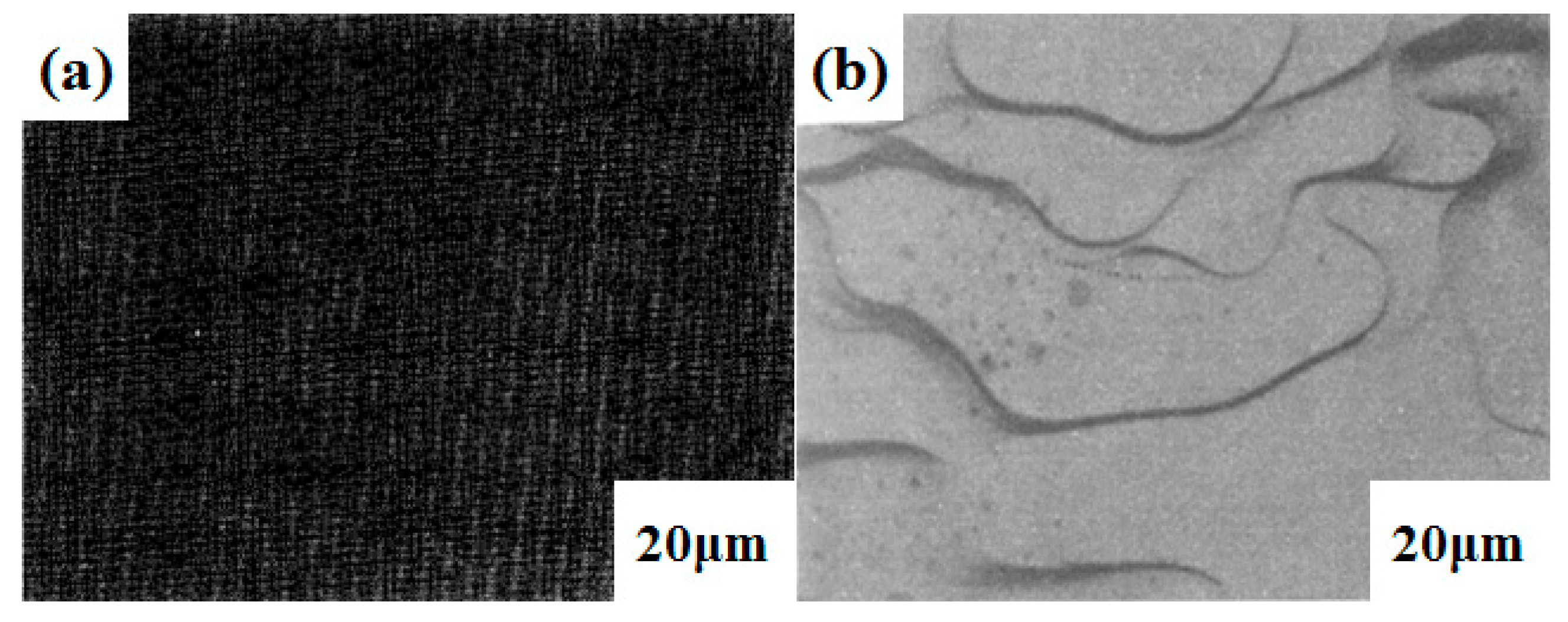
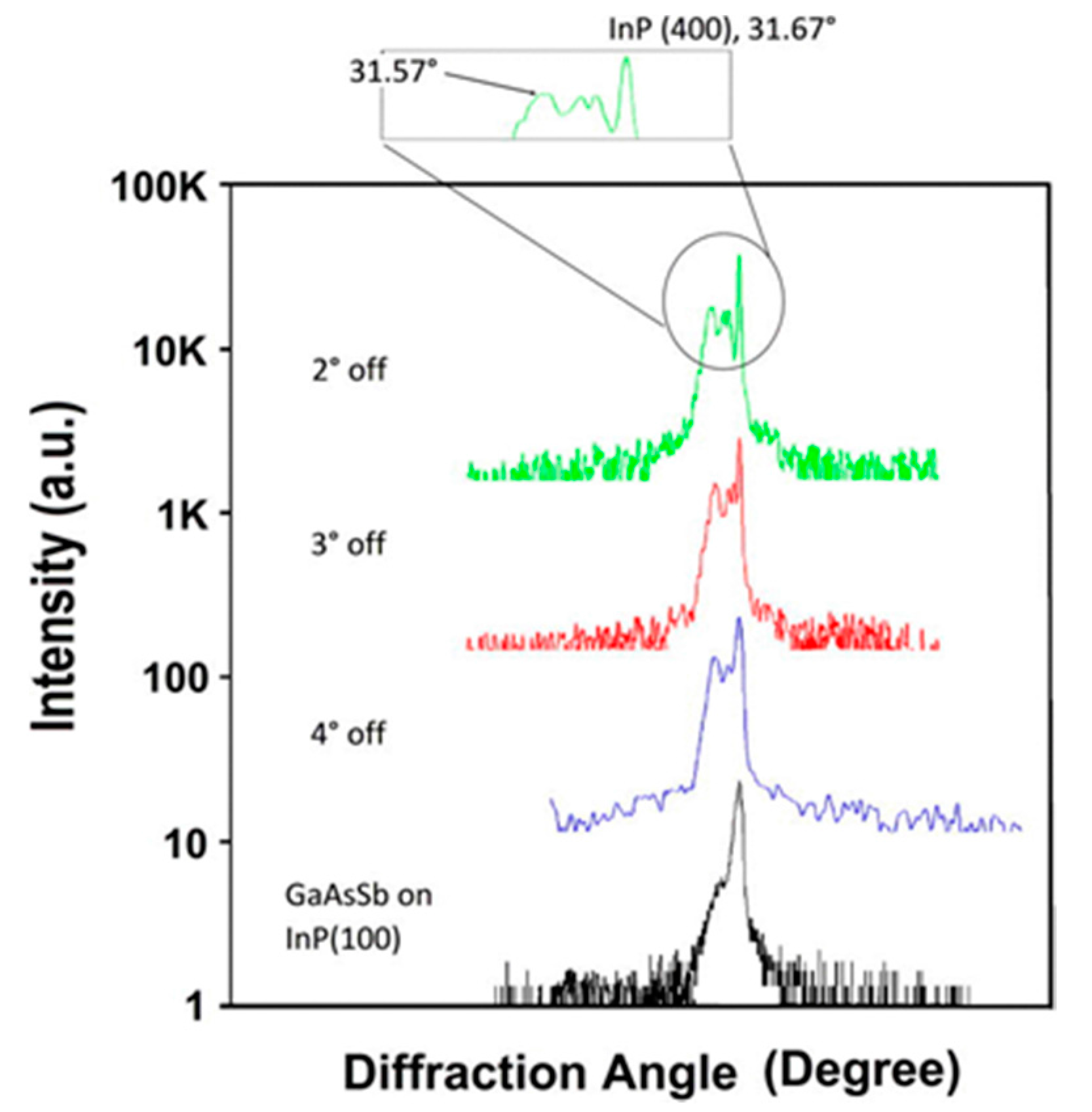
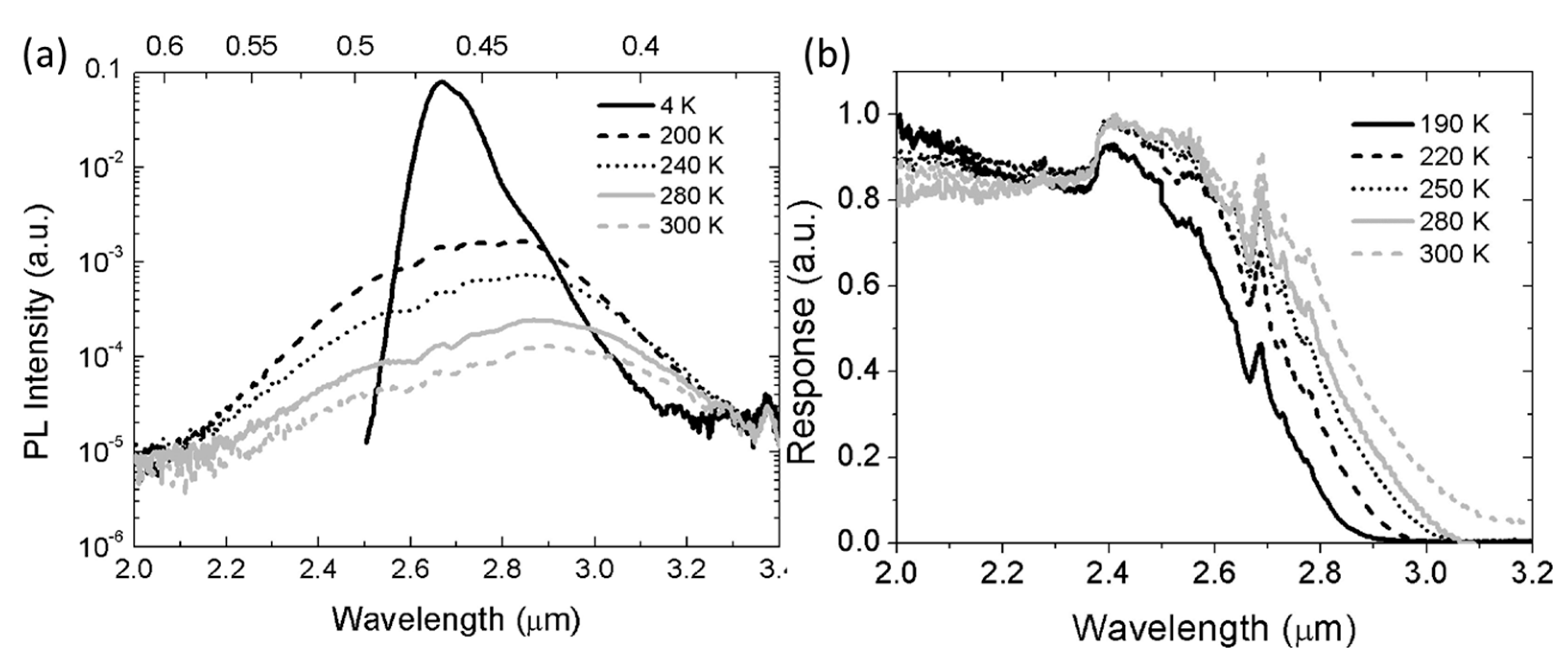
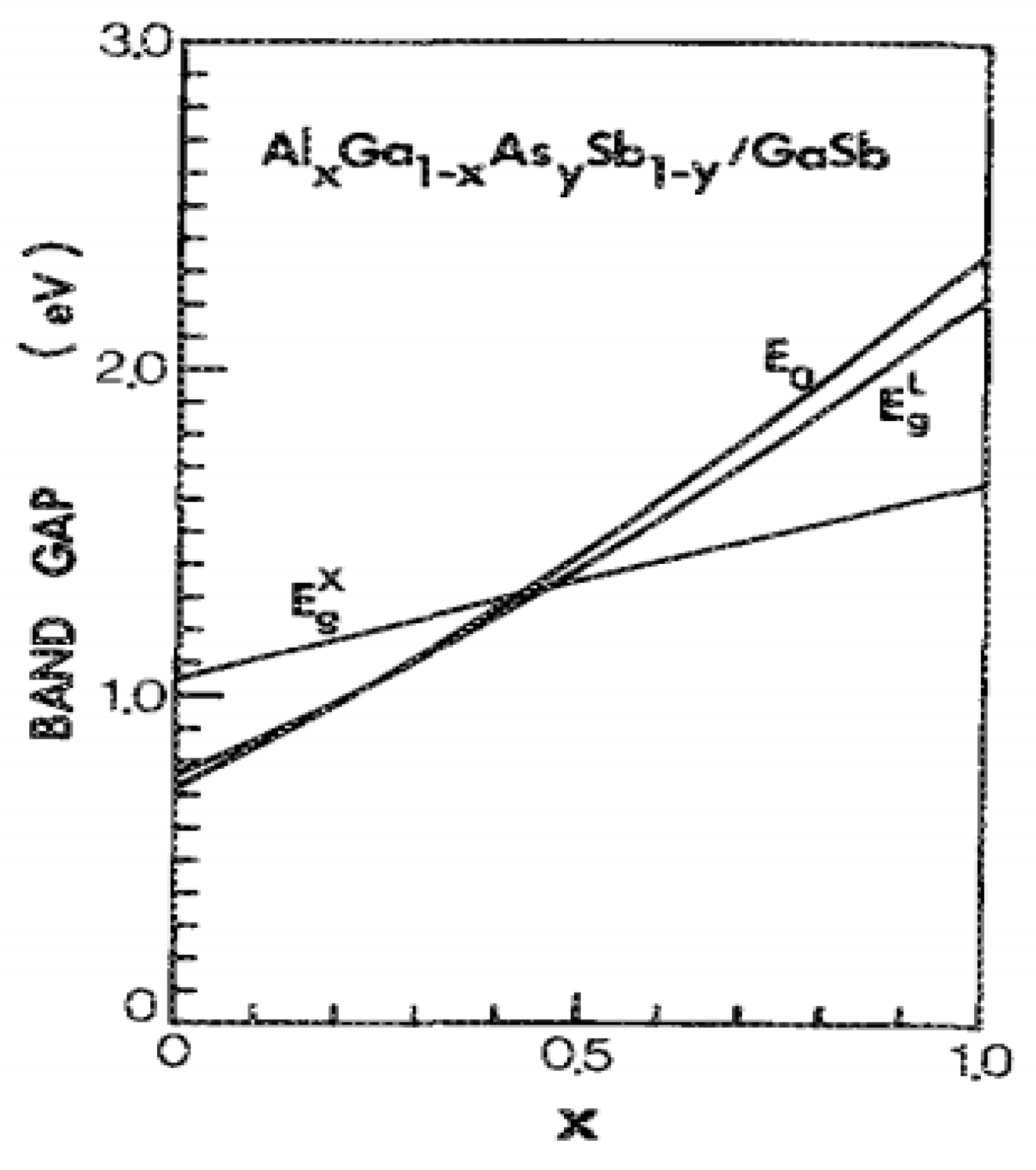
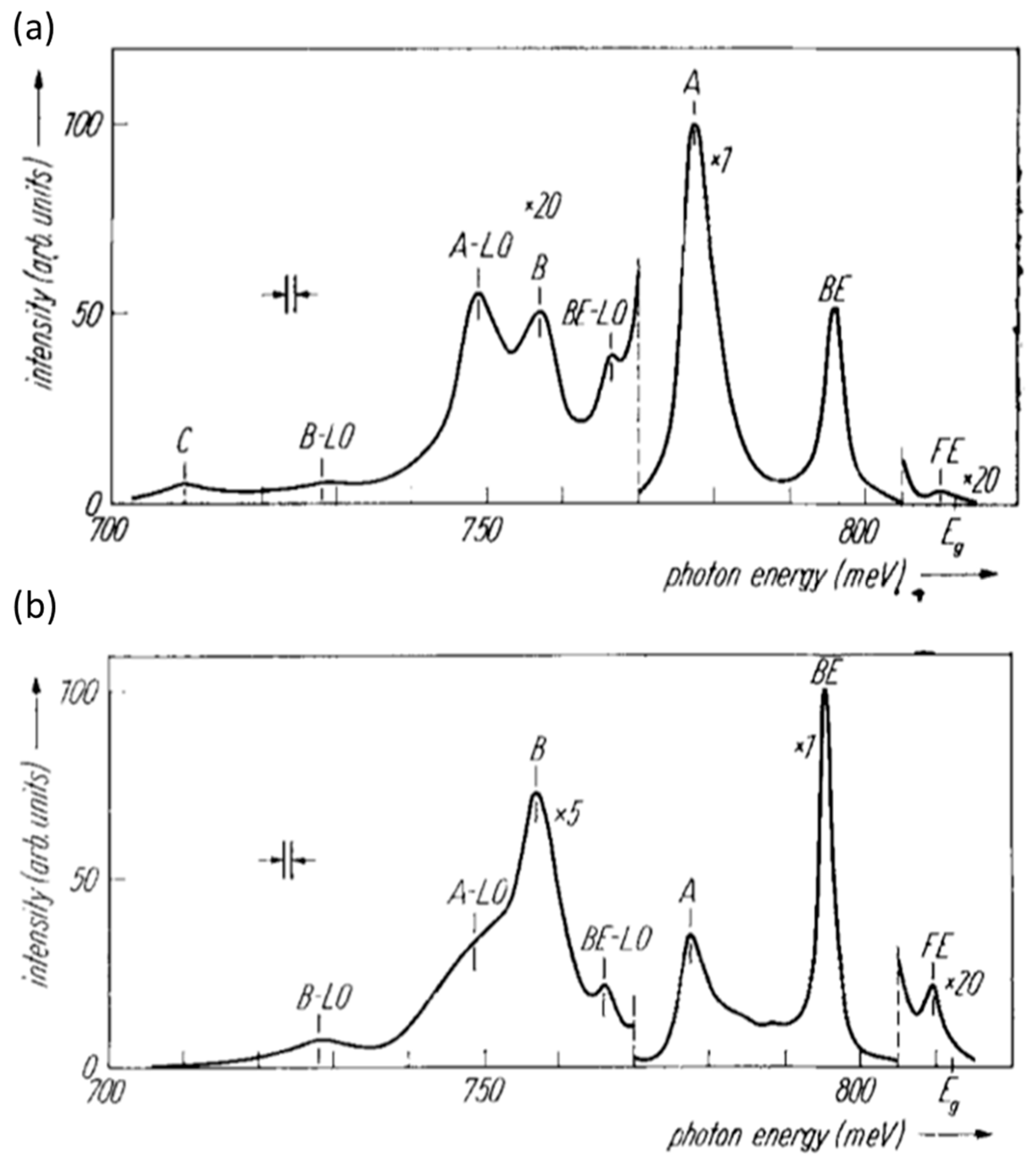

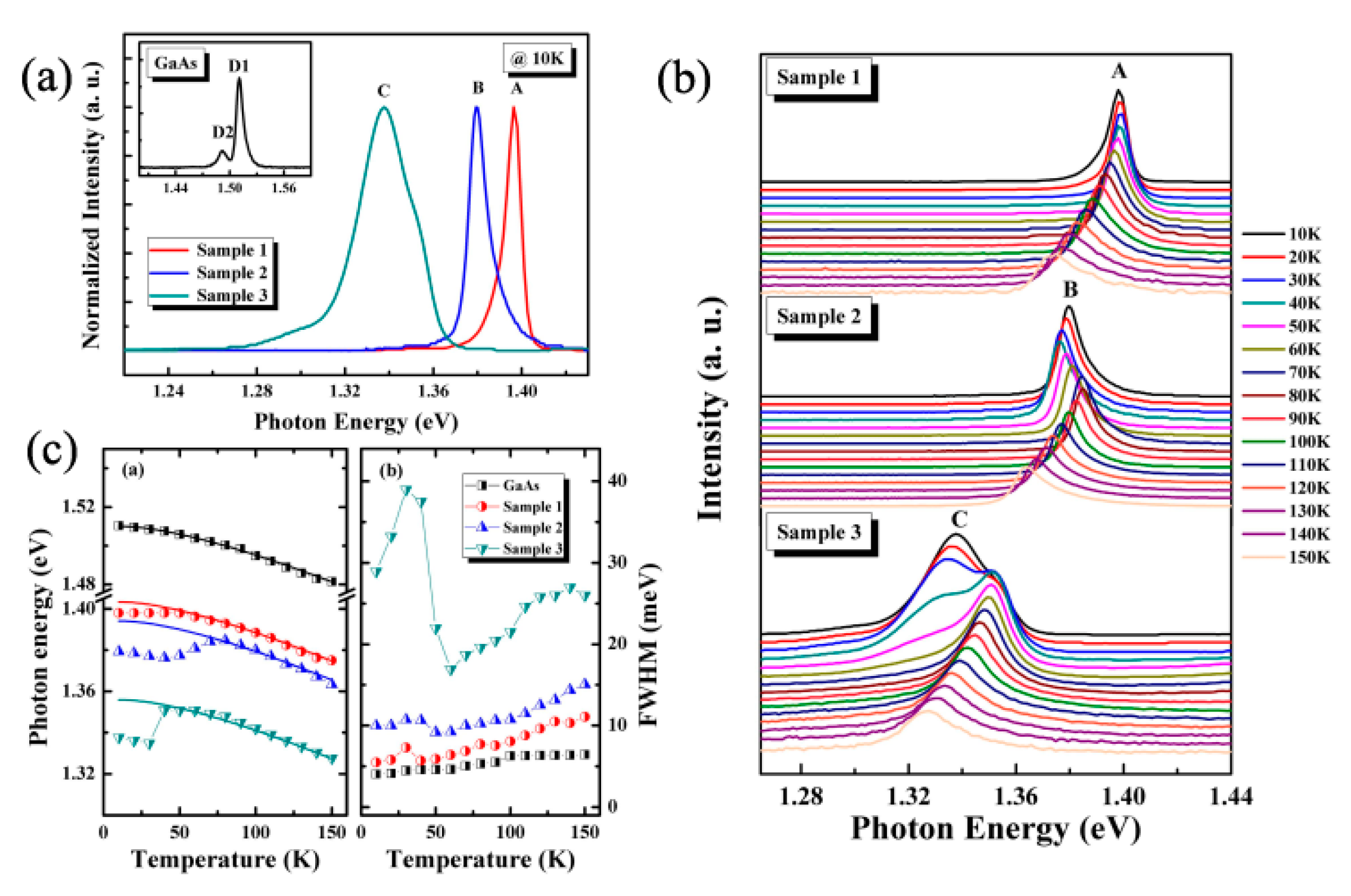
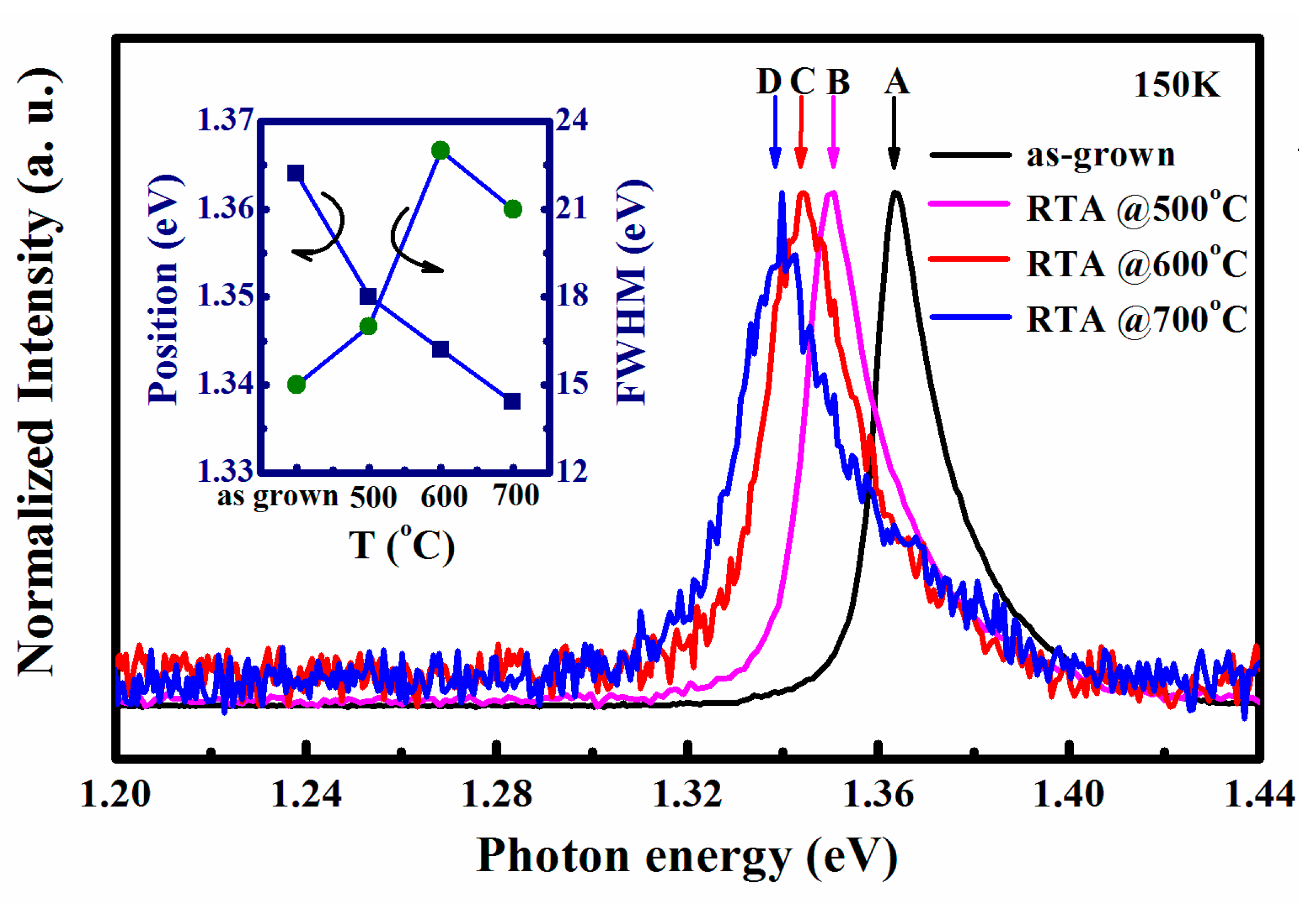

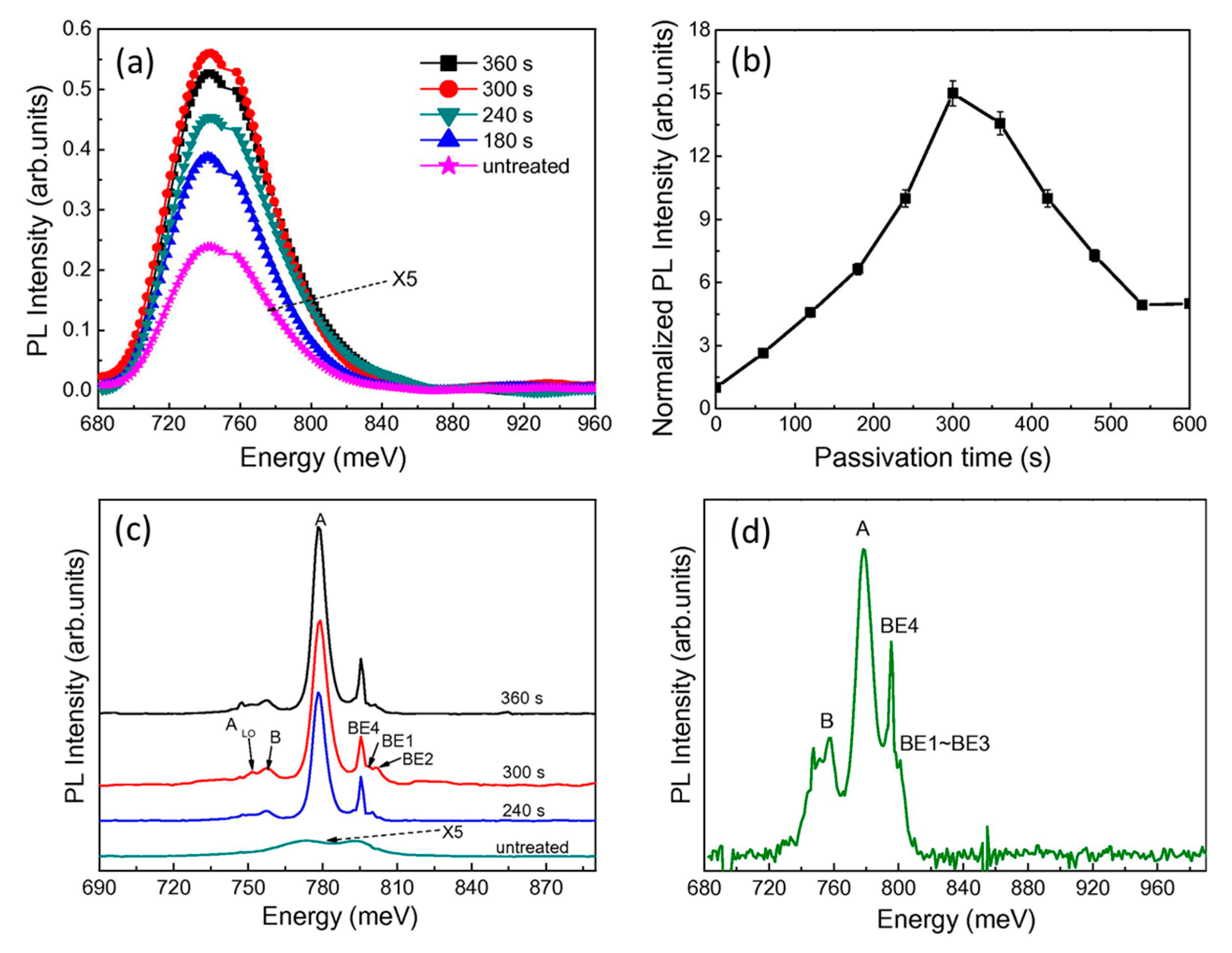
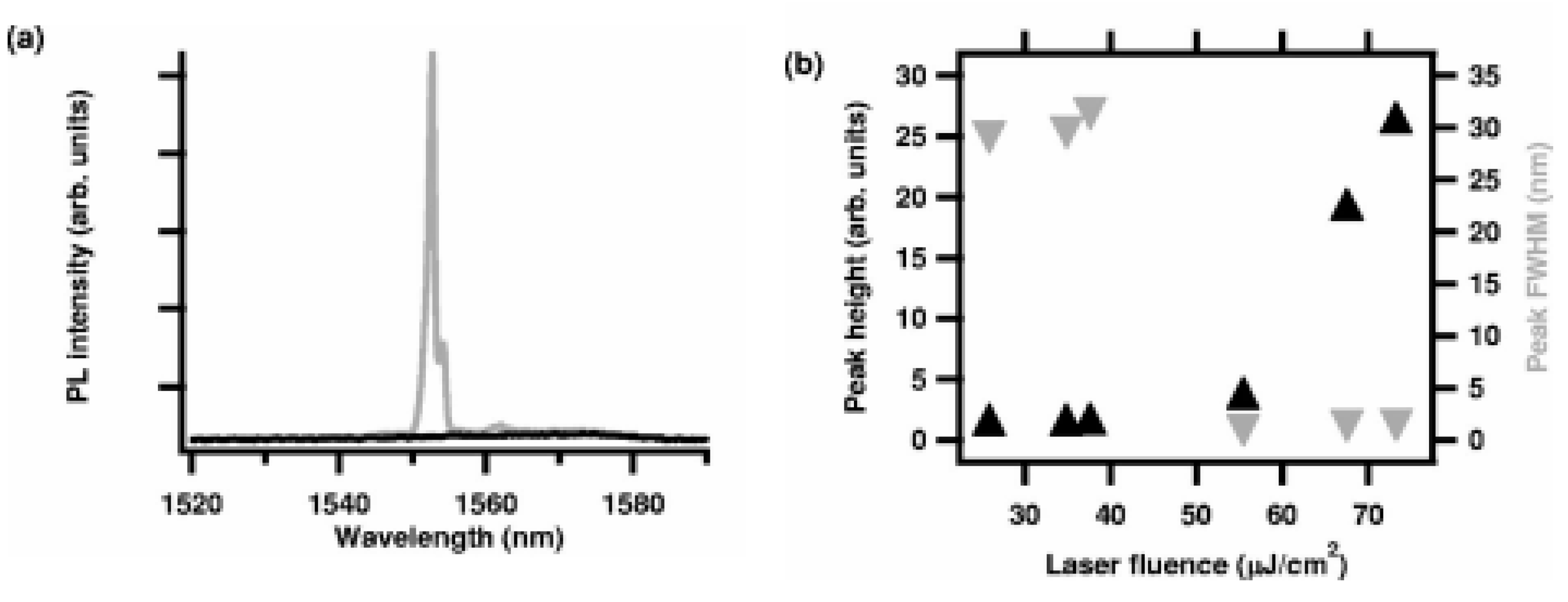
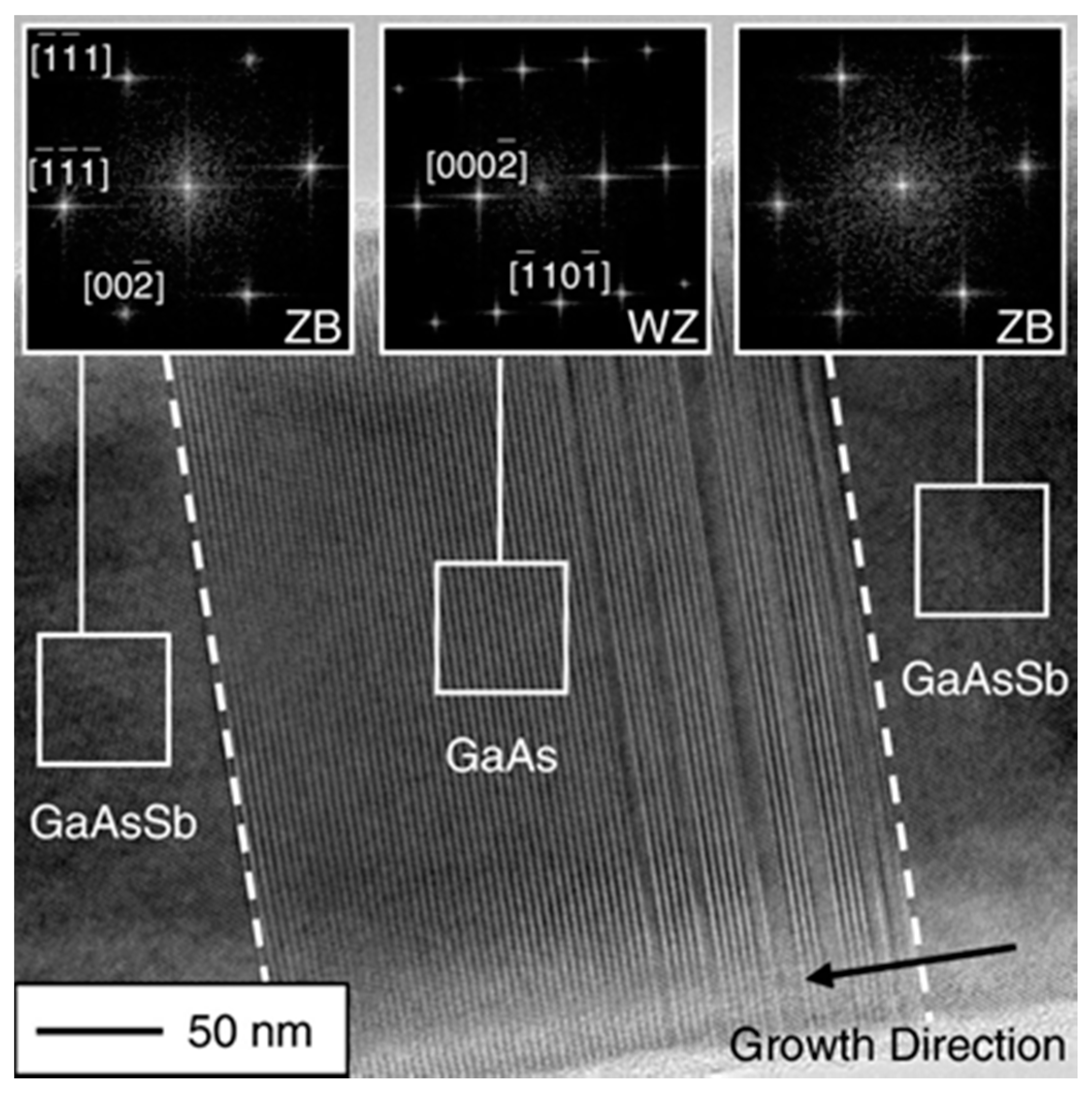

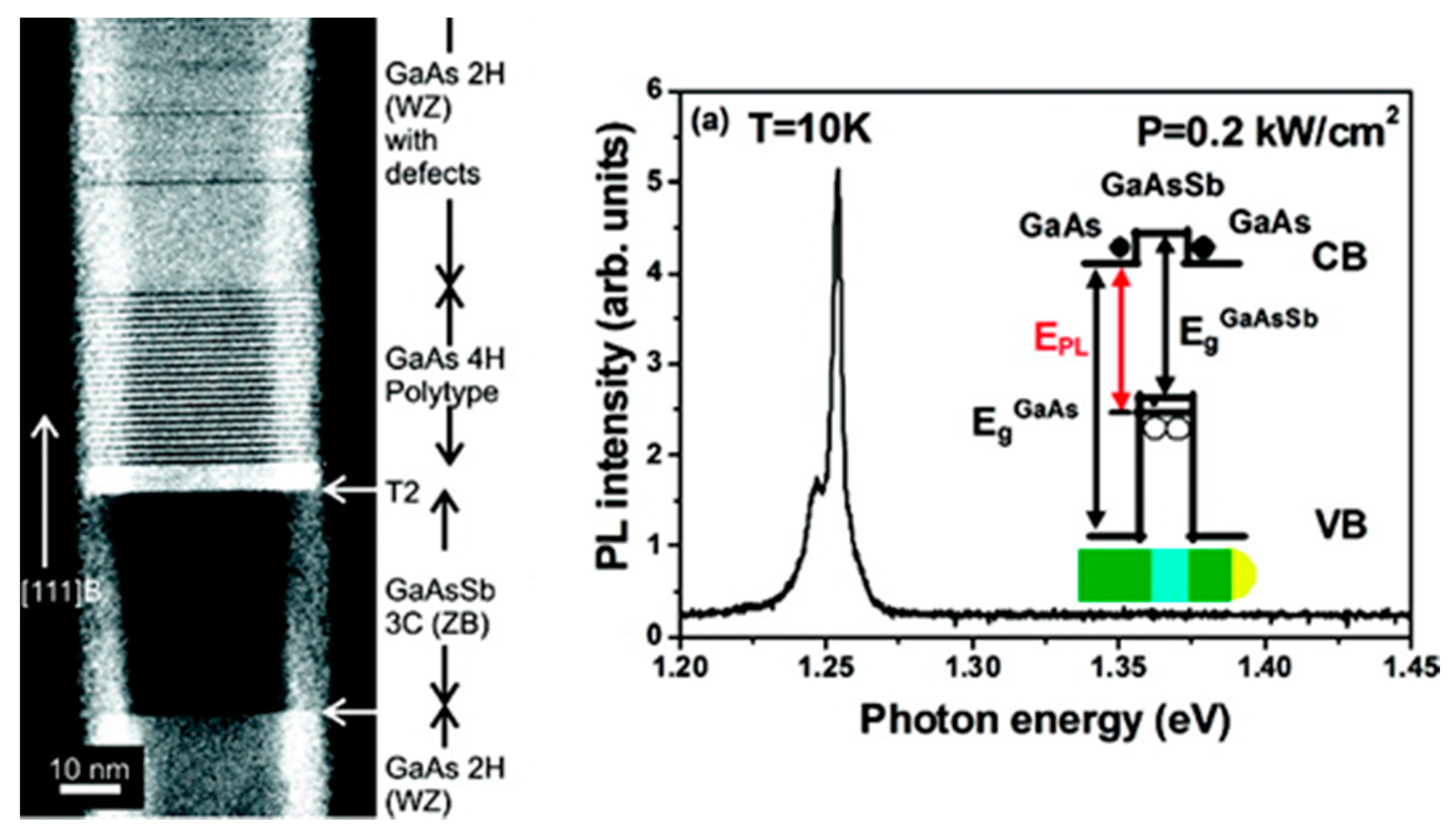

| Sample | Growth Temperature | As/Sb Beam Ratio | Sb Component |
|---|---|---|---|
| 1 | 28:1 | 6% | |
| 2 | 600 °C | 16:1 | 8% |
| 3 | 7:1 | 9% |
| Sample | Relaxation Degree (%) | Stoichiometry Coefficient x y | Lattice Constant (Å) | Lattice Mismatch (ppm), Relaxed | Lattice Mismatch (ppm),()−1 | |
|---|---|---|---|---|---|---|
| #A01T | 45 | 0.430 | -- | 6.11255 | 2814 | 2837 |
| #A02T | 10 | 0.355 | -- | 6.10956 | 2324 | 4267 |
| #A03T | 44 | 0.480 | -- | 6.11455 | 3142 | 4782 |
| #A01Q | 0 | 0.430 | 0.0437 | 6.09277 | −431 | −820 |
| #A02Q | 10 | 0.355 | 0.0045 | 6.10753 | 1989 | 3664 |
| #A03Q | 0 | 0.480 | 0.0319 | 6.09997 | 750 | 1463 |
| Line | hυ (mev) | |
|---|---|---|
| FE | 810 | free exciton |
| BE | 795.5 | bound exciton |
| A | 777.5 | band-acceptor transition EA = 34.5 meV |
| BE-LO | 766 | phonon replica of line BE (LO)Γ-phonon: (hυ)Ph = 29.5 meV |
| B | 757 | band-acceptor transition EB = 55 meV |
| A-LO | 748.5 | phonon replica of line A (LO)Γ-phonon: (hυ)Ph = 29 meV |
| B-LO | 728 | phonon replica of line B (LO)Γ-phonon: (hυ)Ph = 29 meV |
| C | 710 | band-acceptor transition Ec = 102 meV second ionization step of the acceptor involved in line A |
| D | 803 | band-acceptor transition? ED = 9 meV |
| Energy (meV) | FWHM (meV) | Notation |
|---|---|---|
| 806 | 3 | BE1 |
| 802 | 2 | BE2 or BE3 |
| 800–790 | Unresolved | BE4 and other acceptor related transitions |
| 785 | 10–15 | Unidentified acceptor U1 |
| 775 | 5 | |
| 757 | Unresolved | |
| 746 | 7–8 | Phonon replica |
| 725 | 10 | |
| 722 | Unresolved | |
| 717 | 2–3 | |
| 710 | 5 |
© 2017 by the authors. Licensee MDPI, Basel, Switzerland. This article is an open access article distributed under the terms and conditions of the Creative Commons Attribution (CC BY) license (http://creativecommons.org/licenses/by/4.0/).
Share and Cite
Niu, S.; Wei, Z.; Fang, X.; Wang, D.; Wang, X.; Gao, X.; Chen, R. Brief Review of Epitaxy and Emission Properties of GaSb and Related Semiconductors. Crystals 2017, 7, 337. https://doi.org/10.3390/cryst7110337
Niu S, Wei Z, Fang X, Wang D, Wang X, Gao X, Chen R. Brief Review of Epitaxy and Emission Properties of GaSb and Related Semiconductors. Crystals. 2017; 7(11):337. https://doi.org/10.3390/cryst7110337
Chicago/Turabian StyleNiu, Shouzhu, Zhipeng Wei, Xuan Fang, Dengkui Wang, Xinwei Wang, Xian Gao, and Rui Chen. 2017. "Brief Review of Epitaxy and Emission Properties of GaSb and Related Semiconductors" Crystals 7, no. 11: 337. https://doi.org/10.3390/cryst7110337






